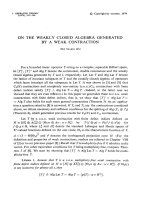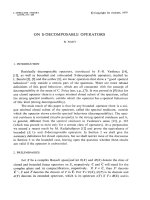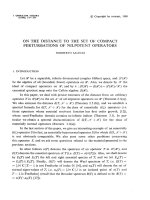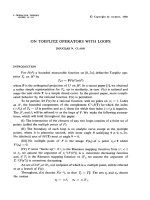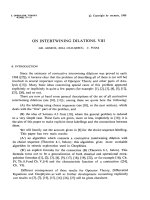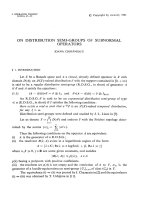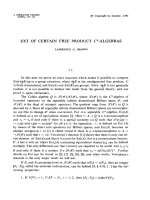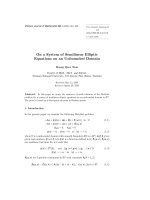Báo cáo toán học: " On an Invariant-Theoretic Description of the Lambda Algebra" ppsx
Bạn đang xem bản rút gọn của tài liệu. Xem và tải ngay bản đầy đủ của tài liệu tại đây (157.13 KB, 14 trang )
Vietnam Journal of Mathematics 33:1 (2005) 19–32
On an Inva riant-Theoretic Description
of the Lambda Algebra
*
Nguyen Sum
Department of Mathematics, University of Quy Nhon,
170 An Duong Vuong, Q uy Nhon, Binh Dinh, Vietnam
Received May 12, 2003
Revised September 15, 2004
Dedicated to Professor Hu`ynh M`ui on the occasion of his sixtieth birthday
Abstract
The purpose of this paper is to give a mod-p analogue of the Lomonaco
invariant-theoretic description of the lambda algebra for
p an odd prime. More pre-
cisely, using modular invariants of the general linear group
GL
n
= GL(n, F
p
) and its
Borel subgroup
B
n
, we construct a differential algebra Q
−
which is isomorphic to the
lambda algebra
Λ=Λ
p
.
Introduction
For the last few decades, the modular invariant theory has been playing an
important role in stable homotopy theory. Singer [9] gave an interpretation for
the dual of the lambda algebra Λ
p
, which was introduced by the six authors
[1], in terms of modular invariant theory of the general linear group at the
prime p = 2. In [8], Hung and the author gave a mod-p analogue of the Singer
invariant-theoretic description of the dual of the lambda algebra for p an odd
prime. Lomonaco [6] also gave an interpretation for the lambda algebra in terms
of modular invariant theory of the Borel subgroup of the general linear group at
p =2.
∗
This work was supported in part by the Vietnam National Research Program Grant 140801.
20 Nguyen Sum
The purpose of this paper is to give a mod-p analogue of the Lomonaco
invariant-theoretic description of the lambda algebra for p an odd prime. More
precisely, using modular invariants of the general linear group GL
n
= GL(n, F
p
)
and its Borel subgroup B
n
, we construct a differential algebra Q
−
which is iso-
morphic to the lambda algebra Λ = Λ
p
. Here and in what follows, F
p
denotes the
prime field of p elements. Recall that, Λ
p
is the E
1
-term of the Adams spectral
sequence of spheres for p an odd prime, whose E
2
-term is Ext
∗
A(p)
(F
p
, F
p
)where
A(p) denotes the mod p Steenrod algebra, and E
∞
-term is a graded algebra
associated to the p-primary components of the stable homotopy of spheres.
It should be noted that the idea for the invariant-theoretic description of the
lambda algebra is due to Lomonaco, who realizes it for p = 2 in [6]. In this
paper, we develope of his work for p any odd prime. Our main contributions are
the computations at odd degrees, where the behavior of the lambda algebra is
completely different from that for p =2.
The paper contains 4 sections. Sec. 1 is a preliminary on the modular invari-
ant theory and its localization. In Sec. 2 we construct the differential algebra Q
by using modular invariant theory and show that Q can be presented by a set of
generators and some relations on them. In Sec. 3 we recall some results on the
lambda algebra and show that it is isomorphic to a differential subalgebra Q
−
of Q. Finally, in Sec. 4 we give an F
p
-vector space basis for Q.
1. Preliminaries on the Invariant Theory
For an odd prime p,letE
n
be an elementary abelian p-group of rank n,andlet
H
∗
(BE
n
)=E(x
1
,x
2
, ,x
n
) ⊗ F
p
(y
1
,y
2
, ,y
n
)
be the mod-p cohomology ring of E
n
. It is a tensor product of an exterior algebra
on generators x
i
of dimension 1 with a polynomial algebra on generators y
i
of
dimension 2. Here and throughout the paper, the coefficients are taken over the
prime field F
p
of p elements.
Let GL
n
= GL(n, F
p
)andB
n
be its Borel subgroup consisting of all invert-
ible upper triangular matrices. These groups act naturally on H
∗
(BE
n
). Let S
be the multiplicative subset of H
∗
(BE
n
) generated by all elements of dimension
2andlet
Φ
n
= H
∗
(BE
n
)
S
be the localization of H
∗
(BE
n
) obtained by inverting all elements of S.The
action of GL
n
on H
∗
(BE
n
) extends to an action of its on Φ
n
. We recall here
some results on the invariant rings Γ
n
=Φ
GL
n
n
and Δ
n
=Φ
B
n
n
.
Let L
k,s
and M
k,s
denote the following graded determinants (in the sense of
Mui [3])
On an Invariant-Theoretic Description of the Lambda Algebra 21
L
k,s
=
y
1
y
2
y
k
y
p
1
y
p
2
y
p
k
.
.
.
.
.
.
.
.
.
y
p
s−1
1
y
p
s−1
2
y
p
s−1
k
y
p
s+1
1
y
p
s+1
2
y
p
s+1
k
.
.
.
.
.
.
.
.
.
y
p
k
1
y
p
k
2
y
p
k
k
,
M
k,s
=
x
1
x
2
x
k
y
1
y
2
y
k
y
p
1
y
p
2
y
p
k
.
.
.
.
.
.
.
.
.
y
p
s−1
1
y
p
s−1
2
y
p
s−1
k
y
p
s+1
1
y
p
s+1
2
y
p
s+1
k
.
.
.
.
.
.
.
.
.
y
p
k−1
1
y
p
k−1
2
y
p
k−1
k
.
for 0 ≤ s ≤ k ≤ n and M
k,k
=0. WesetL
k
= L
k,k
, 1 ≤ k ≤ n, L
0
= 1. Recall
that L
k
is invertible in Φ
n
.
As is well known L
k,s
is divisible by L
k
. Dickson invariants Q
k,s
and Mui
invariants R
k,s
,V
k
, 0 ≤ s ≤ k, are defined by
Q
k,s
= L
k,s
/L
k
,R
k,s
= M
k,s
L
p−2
k
,V
k
= L
k
/L
k−1
.
Note that dim Q
k,s
=2(p
k
− p
s
), dim R
k,s
=2(p
k
− p
s
) −1, dim V
k
=2p
k−1
,
Q
k,0
= L
p−1
k
,L
k
= V
k
V
k−1
V
2
V
1
.
From the results in Dickson [2] and Mui [3, 4.17] we observe
Theorem 1.1. (see Singer [9])
Γ
n
= E(R
n,0
,R
n,1
, ,R
n,n−1
) ⊗ F
p
(Q
±1
n,0
,Q
n,1
, ,Q
n,n−1
).
Following Li–Singer [7], we set
N
k
= M
k,k−1
L
p−2
k
,W
k
= V
p−1
k
, 1 ≤ k ≤ n.
Then we have
Theorem 1.2. (see Li–Singer [7])
Δ
n
= E(N
1
,N
2
, ,N
n
) ⊗ F
p
(W
±1
1
,W
±1
2
, ,W
±1
n
).
Forlatteruse,weset
t
k
= N
k
/Q
p−1
k−1,0
,w
k
= W
k
/Q
p−1
k−1,0
, 1 ≤ k ≤ n.
Observe that dim t
k
=2p − 3, dim w
k
=2p − 2. From Theorem 1.2 we obtain
22 Nguyen Sum
Corollary 1.3.
Δ
n
= E(t
1
,t
2
, ,t
n
) ⊗ F
p
(w
±1
1
,w
±1
2
, ,w
±1
n
).
Moreover, from Dickson [2], Mui [3], we have
Proposition 1.4.
(i) Q
n,s
= Q
p
n−1,s−1
+ Q
p−1
n−1,0
Q
n−1,s
w
n
,
(ii) R
n,s
= Q
p−1
n−1,0
(R
n−1,s
w
n
+ Q
n−1,s
t
n
).
2. The Algebra Q
In this section, we construct the differential algebra Q by using modular invari-
ant theory. In Sec. 4, we will show that the lambda algeba is isomorphic to a
subalgebra of Q.
Definition 2.1. Let Δ
n
be as in Sec. 1.Set
Δ= ⊕
n≥0
Δ
n
.
Here, by convention, Δ
0
= F
p
. This is a direct sum of vector spaces over F
p
.
Remark. For I =(ε
1
,ε
2
, ,ε
n
,i
1
,i
2
, ,i
n
)withε
j
=0, 1,i
j
∈ Z,set
w
I
= t
ε
1
1
t
ε
2
2
t
ε
n
n
w
i
1
+ε
1
1
w
i
2
+ε
2
2
w
i
n
+ε
n
n
,
even in the case when some of ε
j
or i
j
are zero. For example, the element
t
1
∈ Δ
2
will be written as t
1
t
0
2
w
0
1
w
0
2
, to be distinguished from t
1
∈ Δ
1
,since
t
1
= t
1
t
0
2
w
0
1
w
0
2
. For any n>0wehaveamonomial
t
0
1
t
0
2
t
0
n
w
0
1
w
0
2
w
0
n
∈ Δ
n
which is the identity of Δ
n
. All these elements are distinct in Δ.
Now we equip Δ with an algebra structure as follows. For any non-negative
integers k,, we define an isomorphism of algebras
μ
k,
:Δ
k
⊗ Δ
→ Δ
k+
by setting
μ
k,
(t
ε
1
1
t
ε
2
2
t
ε
k
k
w
i
1
+ε
1
1
w
i
2
+ε
2
2
w
i
k
+ε
k
k
⊗ t
σ
1
1
t
σ
2
2
t
σ
w
j
1
+σ
1
1
w
j
2
+σ
2
2
w
j
+σ
)
= t
ε
1
1
t
ε
2
2
t
ε
k
k
t
σ
1
k+1
t
σ
2
k+2
t
σ
k+
w
i
1
+ε
1
1
w
i
2
+ε
2
2
w
i
k
+ε
k
k
w
j
1
+σ
1
k+1
w
j
2
+σ
2
k+2
w
j
+σ
k+
,
for any i
1
,i
2
, ,i
k
,j
1
,j
2
, ,j
∈ Z,ε
1
,ε
2
, ,ε
k
,σ
1
,σ
2
, ,σ
=0, 1.
We assemble μ
k,
,k,≥ 0, to obtain a multiplication
μ :Δ⊗ Δ → Δ.
This multiplication makes Δ into an algebra.
For simplicity, we denote μ(x ⊗ y)=x ∗ y for any elements x, y ∈ Δ.
On an Invariant-Theoretic Description of the Lambda Algebra 23
Definition 2.2. Let Γ denote the two-sides ideal of Δ generated by all elements
of the forms
t
0
1
t
0
2
w
−1
1
w
0
2
Q
a
2,0
Q
b
2,1
,
t
0
1
t
0
2
w
−1
1
w
0
2
R
2,0
Q
a
2,0
Q
b
2,1
− R
2,1
Q
a
2,0
Q
b
2,1
,
2t
0
1
t
0
2
w
1
w
0
2
R
2,1
Q
a
2,0
Q
b
2,1
− R
2,0
Q
a
2,0
Q
b
2,1
,
t
0
1
t
0
2
w
1
w
0
2
R
2,0
R
2,1
Q
a
2,0
Q
b
2,1
,
where a, b ∈ Z,b≥ 0.
We define
Q =Δ/Γ
to be the quotient of Δ by the ideal Γ.
For any non-negative integer n, we define a homomorphism
¯
δ
n
:Δ
n
→ Δ
n+1
by setting
¯
δ
n
(x)=−t
1
w
−1
1
∗ x +(−1)
dim x
x ∗ t
1
w
−1
1
,
for any homogeneous element x ∈ Δ
n
. By assembling
¯
δ
n
,n ≥ 0, we obtain an
endomorphism
¯
δ :Δ→ Δ.
Theorem 2.3. The endomorphism
¯
δ :Δ→ Δ induces an endomorphism δ :
Q → Q which is a differential.
Proof. Let u ∈ Δ
n
be a homogeneous element and suppose u ∈ Γ. From the
definition of Γ we see that u is a sum of elements of the form
u
i
∗ s
i
∗ z
i
,
where u
i
∈ Δ
n
i
,z
i
∈ Δ
n−n
i
−2
and s
i
is one of the elements given in Definition
2.2. Then
¯
δ(u)isasumofelementsoftheform
−t
1
w
−1
1
∗ u
i
∗ s
i
∗ z
i
+(−1)
dim u
u
i
∗ s
i
∗ z
i
∗ t
1
w
−1
1
.
Since t
1
w
−1
1
∗ u
i
∈ Δ
n
i
+1
,z
i
∗ t
1
w
−1
1
∈ Δ
n−n
i
−1
, we obtain
¯
δ(u) ∈ Γ. So,
¯
δ
induces an endomorphism
δ : Q → Q.
Now we prove that δδ = 0. It suffices to check that if x ∈ Δ
n
is a homogeneous
element then
¯
δ
¯
δ(x) ∈ Γ. In fact, from the definition of
¯
δ we have
¯
δ
¯
δ(x)=t
1
t
2
w
−1
1
w
−1
2
∗ x − x ∗ t
1
t
2
w
−1
1
w
−1
2
.
A direct computation using Proposition 1.4 shows that
R
2,0
Q
−1
2,0
= t
1
t
0
2
w
−1
1
w
0
2
+ t
0
1
t
2
w
0
1
w
−1
2
,
R
2,1
Q
−1
2,0
= t
0
1
t
2
w
−1
1
w
−1
2
.
24 Nguyen Sum
From these, we have
t
0
1
t
0
2
w
1
w
0
2
R
2,0
R
2,1
Q
−2
2,0
= t
1
t
2
w
−1
1
w
−1
2
.
Hence we obtain
¯
δ
¯
δ(x)=t
0
1
t
0
2
w
1
w
0
2
R
2,0
R
2,1
Q
−2
2,0
∗ x − x ∗ t
0
1
t
0
2
w
1
w
0
2
R
2,0
R
2,1
Q
−2
2,0
∈ Γ.
The theorem is proved.
Now we give a new system of generators for Q.
Let T be the free associative algebra over F
p
generated by x
i+1
of degree
2(p − 1)i − 1andy
i+1
of degree 2(p − 1)i, for any i ∈ Z.
It is easy to see that there exists a unique derivation D : T → T satisfying
D(x
i
)=x
i−1
,D(y
i
)=y
i−1
,i∈ Z.
(Recall that D is called a derivation if D(uv)=D(u)v+uD(v), for any u, v ∈ T .)
Denote by D
n
= D ◦ D ◦ ◦ D the composite of n-copies of D.
For simplicity, we set
x
ε
i
=
x
i
,ε=1
y
i
,ε=0.
By induction on n we easily obtain
Lemma 2.4. Under the above notation, we have
D
n
(x
ε
1
q
1
x
ε
2
q
2
)=
n
k=0
n
k
x
ε
1
q
1
−k
x
ε
2
q
2
−n+k
.
Here
n
k
denotes the binomial coefficient.
We define a homomorphism of algebras π : T → Q by setting
π(x
i+1
)=t
1
w
i−1
1
,π(y
i+1
)=t
0
1
w
i
1
,i∈ Z.
That means π(x
ε
i+1
)=t
ε
1
w
i−ε
1
for any i ∈ Z,ε=0, 1.
Proposition 2.5. The homomorphism π : T → Q is an epimorphism. Its kernel
is the two-sides ideal of T generated by all elements of the forms
D
n
(y
pi
y
i+1
),
D
n
(x
pi
y
i+1
),
D
n
(y
pi+1
x
i+1
− x
pi+1
y
i+1
),
D
n
(x
pi+1
x
i+1
),
with n ≥ 0,i∈ Z.
Proof. It is easy to see that π is an epimorphim. Now we prove the remaining
part of the proposition.
On an Invariant-Theoretic Description of the Lambda Algebra 25
By a direct computation we obtain
Q
a
2,0
Q
b
2,1
=
b
k=0
b
k
t
0
1
t
0
2
w
p(a+b)−b+k
1
w
a+b−k
2
R
2,0
Q
a
2,0
Q
b
2,1
=
b
k=0
b
k
t
1
t
0
2
w
p(a+b+1)−b+k−1
1
w
a+b+1−k
2
+
b
k=0
b
k
t
0
1
t
2
w
p(a+b+1)−b+k
1
w
a+b−k
2
R
2,1
Q
a
2,0
Q
b
2,1
=
b
k=0
b
k
t
0
1
t
2
w
p(a+b+1)−b+k−1
1
w
a+b−k
2
R
2,0
R
2,1
Q
a
2,0
Q
b
2,1
=
b
k=0
b
k
t
1
t
2
w
p(a+b+2)−b+k−2
1
w
a+b+1−k
2
.
Using Lemma 2.4 and the definition of π we have
π(D
n
(y
pi
y
i+1
)) = π
n
k=0
n
k
y
pi−n+k
y
i+1−k
=
n
k=0
n
k
t
0
1
t
0
2
w
pi−n+k−1
1
w
i−k
2
= t
0
1
t
0
2
w
−1
1
w
0
2
n
k=0
n
k
t
0
1
t
0
2
w
pi−n+k
1
w
i−k
2
= t
0
1
t
0
2
w
−1
1
w
0
2
Q
i−n
2,0
Q
n
2,1
=0 inQ.
By an argument analogous to the previous one, we get
π(D
n
(x
pi
y
i+1
)) = t
0
1
t
0
2
w
−1
1
w
0
2
R
2,0
Q
i−n−1
2,0
Q
n
2,1
− R
2,1
Q
i−n−1
2,0
Q
n
2,1
=0 inQ
π(D
n
(y
pi+1
x
i+1
− x
pi+1
y
i+1
)) = (2t
0
1
t
0
2
w
1
w
0
2
R
2,1
− R
2,0
)Q
i−n−1
2,0
Q
n
2,1
=0 inQ
π(D
n
(x
pi+1
x
i+1
)) = −t
0
1
t
0
2
w
1
w
0
2
R
2,0
R
2,1
Q
i−n−2
2,0
Q
n
2,1
=0 inQ.
From these and the definition of Γ we obtain the proposition.
3. The Lambda Algebra and the Modular Invariant Theory
In this section, we show that the lambda algebra, which is introduced by the six
authors of [1], is isomorphic to a subalgebra of Q.
Let
¯
Λ denote the graded free associative algebra over F
p
with generators λ
i−1
of dimension −2(p − 1)i +1andμ
i−1
of dimension −2(p − i),i≥ 0, subject to
26 Nguyen Sum
the relations:
n
k=0
n
k
λ
k+pi−1
λ
i+n−k−1
=0 (1)
n
k=0
n
k
μ
k+pi−1
λ
i+n−k−1
− λ
k+pi−1
μ
i+n−k−1
=0 (2)
n
k=0
n
k
λ
k+pi
μ
i+n−k−1
=0 (3)
n
k=0
n
k
μ
k+pi
μ
i+n−k−1
=0 (4)
for i, n ≥ 0. By Λ we mean the subalgebra of
¯
Λ generated by λ
i−1
,i > 0and
μ
i−1
,i≥ 0.
We note that this definition is the same as that given in [1], but we are
writing the product in the order opposite to that used in [1].
For simplicity, we denote
λ
ε
i
=
λ
i
,ε=1
μ
i
,ε=0,
for any i ≥−1. We set
λ(ε
1
,ε
2
,i,n)=
n
k=0
n
k
λ
ε
1
k+pi−ε
2
λ
ε
2
i+n−k−1
− ε
2
(1 − ε
1
)λ
ε
2
k+pi−ε
2
λ
ε
1
i+n−k−1
,
for any ε
1
,ε
2
,i,n with ε
1
,ε
2
=0, 1andi, n ≥ 0. Then the defining relations
(1) - (4) become
λ(ε
1
,ε
2
,i,n)=0. (5)
Then we can consider Λ as the free graded associative algebra over F
p
with
generators λ
ε
i−1
,i≥ ε, subject to the relation (5) with i ≥−ε
1
.
Definition 3.1. AsequenceI =(ε
1
,ε
2
, ,ε
n
,i
1
,i
2
, ,i
n
),ε
j
=0, 1,i
j
≥ 0,
is said to be admissible if
pi
j
≥ i
j+1
+ ε
j
, 1 ≤ j<n, and i
n
≥ ε
n
.
In this case, the associated monomial λ
I
= λ
ε
1
i
1
−1
λ
ε
2
i
2
−1
λ
ε
n
i
n
−1
is also said
to be admissible
Theorem 3.2. (Bousfield et al. [1]) The admissible monomials form an additive
basis for Λ.
Definition 3.3. The homomorphism
¯
d :
¯
Λ →
¯
Λ is defined by
¯
d(x)=−λ
−1
x +(−1)
dim x
xλ
−1
,
On an Invariant-Theoretic Description of the Lambda Algebra 27
for any homogeneous element x ∈
¯
Λ.
In
¯
Λ, we have λ
−1
λ
−1
= 0, hence
¯
d
¯
d =0. So
¯
d is a differential on
¯
Λ. From
the defining relations (1)-(4) we obtain
¯
d(λ
0
)=0,
¯
d(μ
−1
)=0,
¯
d(μ
0
)=λ
0
μ
−1
− μ
−1
λ
0
,
¯
d(λ
n−1
)=
n−1
k=1
n
k
λ
k−1
λ
n−k−1
,
¯
d(μ
n−1
)=λ
n−1
μ
−1
+
n−1
k=1
n
k
λ
k−1
μ
n−k−1
− μ
k−1
λ
n−k−1
− μ
−1
λ
n−1
,
for any n ≥ 2. From these, we obtain
¯
d(λ
ε
n−1
) ∈ Λ,n ≥ ε, so
¯
d passes to a
differential d on Λ.
Now we describe the algebra Λ in terms of modular invariants.
Definition 3.4. We define Q
−
to be the subalgebra of Q generated by all ele-
ments x
ε
i+1
with i ≤−ε.
For any ε
1
,ε
2
=0, 1,n≥ 0,i∈ Z,weset
x(ε
1
,ε
2
,i,n)=D
n
x
ε
1
pi+ε
2
x
ε
2
i+1
− ε
2
(1 − ε
1
)x
ε
2
pi+ε
2
x
ε
1
i+1
.
Then the defining relations of Q become
x(ε
1
,ε
2
,i,n)=0. (6)
So we can consider Q
−
as the free graded associative algebra over F
p
with
generators x
ε
i+1
,i≤−ε, subject to the relation (6) with i ≤−ε
1
.
Theorem 3.5. As a graded differential algebra, Λ is isomorphic to Q
−
.
Proof. We define a homomorphism of algebras
Φ:Λ→ Q
−
by setting
Φ(λ
ε
i−1
)=x
ε
−i+1
,
for any i ≥−ε. From the definition of Q
−
we easily obtain
Φ
λ(ε
1
,ε
2
,i,n)
= x(ε
1
,ε
2
, −i, n)
for any ε
1
,ε
2
=0, 1,i,n≥ 0,i≥ ε
1
. Hence, the homomorphism Φ is well defined.
Now we define a homomorphism of algebras
Ψ:Q
−
→ Λ,
by setting Ψ(x
ε
i+1
)=λ
ε
−i−1
, for any i ≤−ε. It is easy to check that
Ψ
x(ε
1
,ε
2
,i,n)
= λ(ε
1
,ε
2
, −i, n),
28 Nguyen Sum
for any ε
1
,ε
2
=0, 1,n ≥ 0,i ≤−ε
1
. So, the homomorphism Ψ is well defined.
Obviously, we have
Φ ◦ Ψ=1
Q
−
, Ψ ◦ Φ=1
Λ
.
Hence Φ is an isomorphism of algebras.
Finally we prove that Φ preserves the differential structure. We have
Φ(δ(λ
n−1
)) = Φ
n−1
k=1
n
k
λ
k−1
λ
n−k−1
=
n−1
k=1
n
k
x
−k+1
x
k−n+1
= d(x
−n+1
)
= dΦ(λ
n−1
),
for any n ≥ 1. Similarly, we obtain
Φ(δ(μ
n−1
)) = dΦ(μ
n−1
),
for any n ≥ 0. So Φ is an isomorphism of differential algebras. The theorem is
proved.
4. An Additive Basis for Q
For J =(ε
1
,ε
2
, ,ε
n
,j
1
,j
2
, ,j
n
), with ε
k
=0, 1,j
k
∈ Z,k =1, 2, ,n, we
set
x
J
= x
ε
1
j
1
+1
x
ε
2
j
2
+1
x
ε
n
j
n
+1
.
Definition 4.1. The monomial x
J
is said to be admissible if
j
k
≥ pj
k+1
+ ε
k+1
,k =1, 2, ,n.
Denote by J
n
the set of all sequences J such that x
J
is admissible.
We note that if j
k
≤−ε
k
,k=1, 2, ,n,thenx
J
is admissible if and only
if λ
−J
is admissible in Λ. Here
−J =(ε
1
,ε
2
, ,ε
n
, −j
1
, −j
2
, ,−j
n
).
From the relation D
n
(x
pi+1
x
i+1
)=0inQ we have
x
pi−n+1
x
i+1
= −
n−1
k=0
n
k
x
pi−k+1
x
i+1−n+k
. (7)
Applying relations of the same form to those terms of the right hand side of
(7) which are not admissible, after finitely many steps we obtain an expression
of the form
x
pi−n+1
x
i+1
=
a
n,k
x
pi−k+1
x
i+1−n+k
, (8)
On an Invariant-Theoretic Description of the Lambda Algebra 29
where a
n,k
∈ F
p
and all the monomials appearing on the right hand side are
admissible (see the proof of Lemma 4.2). That means
a
n,k
=0 if (p +1)k ≥ pn.
By an argument analogous to the previous one, we get
x
pi−n
y
i+1
=
b
n,k
x
pi−k
y
i+1−n+k
, (9)
x
pi−n+1
y
i+1
=
c
n,k
y
pi−k+1
x
i+1−n+k
+
c
n,k
x
pi−k+1
y
i+1−n+k
, (10)
y
pi−n
y
i+1
=
d
n,k
x
pi−k
y
i+1−n+k
, (11)
where b
n,k
,c
n,k
,c
n,k
,d
n,k
∈ F
p
,b
n,k
= c
n,k
= d
n,k
=0if(p +1)k ≥ pn, c
n,k
=0
if (p +1)k>pn.
Lemma 4.2. If k<0 then a
n,k
= b
n,k
= c
n,k
= c
n,k
= d
n,k
=0.
Proof. For simplicity, we only prove a
n,k
= 0. The others can be obtained by
a similar argument. Let x
pi−+1
x
i+1−n+
be an inadmissible term in the right
hand side of (7). Then (p +1) ≥ pn, 0 ≤ <n.Setm =(p +1) − pn =
p(i − n + ) − pi + ≥ 0. Then we have
x
pi−+1
x
i+1−n+
= x
p(i−n+)−m+1
x
(i−n+)+1
.
Applying (7) we get
x
pi−+1
x
i+1−n+
= −
m−1
j=0
m
j
x
p(i−n+)−j+1
x
i−n++1−m+j
= −
m−1
j=0
m
j
x
pi−(−m+j)+1
x
i+1−n+(−m+j)
.
We have
− m + j ≥ − m = − (p +1) + pn = p(n − ) > 0.
Therefore in (8) the coefficient a
n,k
such that a
n,k
= 0, with the lowest possible
k is a
n,0
. Hence a
n,k
=0ifk<0.
The main result of this section is
Theorem 4.3. The set
X =
n≥0
x
J
: J ∈J
n
is an F
p
-vector space basis for Q.
Proof. We first prove that X spans Q.Letx
J
be a monomial in Q. We apply
the relations (8)-(11) and Lemma 4.2 to the inadmissible pairs in x
J
and after
30 Nguyen Sum
a finite number of steps we can write x
J
as a linear combination of monomials
of the form
x
J
x
J
,
where x
J
is an admissible monomial involving generators x
ε
i+1
with i>−ε and
x
J
is a monomial involving generators x
ε
i+1
with i ≤−ε.Thenx
J
∈ Q
−
.
Using Theorem 3.5 we get
Ψ(x
J
)=
α
u
λ
−Ju
,
where α
u
∈ F
p
and λ
−J
u
is an admissible monomial in Λ. From this we obtain
x
J
=
α
u
x
Ju
,
where x
J
u
is an admissible monomial in Q (see Definition 4.1). It is easy to see
that the monomial x
J
x
J
u
is admissible in Q. Therefore X spans Q.
We now prove that the set X is linearly independent. Suppose that
m
u=1
a
u
x
J
u
=0inQ,
with a
u
∈ F
p
,J
u
∈J
n
,u=1, 2, ,m.Then we have
m
u=1
a
u
w
J
u
∈ Γ.
We order the set {w
J
: J ∈J
n
} by agreeing that
w
J
1
>w
J
2
if and only if J
1
>J
2
.
Here the order in Z
2n
is the antilexicographical one.
Suppose that there is an index u such that a
u
=0. Letw
J
be the great-
est monomial of all monomials w
J
u
such that a
u
= 0 and assume that J =
(ε
1
,ε
2
, ,ε
n
,j
1
,j
2
, ,j
n
). Since
n
u=1
a
u
w
J
u
∈ Γ,w
J
is a term in the ex-
pression of elements of the form
t
ε
1
1
t
ε
k−1
k−1
w
j
1
+ε
1
1
w
j
k−1
+ε
k−1
k−1
∗ z ∗ t
ε
k+2
1
t
ε
n
n−k−2
w
j
k+2
+ε
k+2
1
w
j
n
+ε
n
n−k−2
,
where 1 ≤ k ≤ n − 2andz is one of the elements given in Definition 2.3.
If z = t
0
1
t
0
2
w
−1
1
w
0
2
Q
a
2,0
Q
b
2,1
then
z =
b
j=0
b
j
t
0
1
t
0
2
w
p(a+b)−b+j−1
1
w
a+b−j
2
.
Since w
J
is the greatest monomial, from this we get j
k
= p(a+ b)− b− 1,j
k+1
=
a + b, ε
k+1
=0. Hence
pj
k+1
+ ε
k+1
= p(a + b) >p(a + b) − b − 1=j
k
.
On an Invariant-Theoretic Description of the Lambda Algebra 31
If z = t
0
1
t
0
2
w
−1
w
0
2
R
2,0
Q
a
2,0
Q
b
2,1
− R
2,1
Q
a
2,0
Q
b
2,1
then
z =
b
j=0
b
j
t
1
t
0
2
w
p(a+b)−b+j−2
1
w
a+b+1−j
2
.
Hence j
k
= p(a + b +1)− b − 1,j
k+1
= a + b +1,ε
k+1
=0,and
p
j
k+1
+ ε
k+1
= p(a + b +1)>p(a + b +1)− b − 1=j
k
.
If z =2t
0
1
t
0
2
w
1
w
0
2
R
2,1
Q
a
2,0
Q
b
2,1
− R
2,0
Q
a
2,0
Q
b
2,1
then
z =
b
j=0
b
j
t
0
1
t
2
w
p(a+b+1)−b+j
1
w
a+b−j
2
−
b
j=0
b
j
t
1
t
0
2
w
p(a+b+1)−b+j−1
1
w
a+b+1−j
2
.
From this we obtain j
k
= p(a + b +1)− b, j
k+1
= a + b +1,ε
k+1
=1. Hence
pj
k+1
+ ε
k+1
= p(a + b +1)+1>p(a + b +1)− b = j
k
.
If z = t
0
1
t
0
2
w
1
w
0
2
R
2,0
R
2,1
Q
a
2,0
Q
b
2,1
then
z =
b
j=0
b
j
t
1
t
2
w
p(a+b+2)−b+k−1
1
w
a+b+1−k
2
.
Hence j
k
= p(a + b +2)− b, j
k+1
= a + b +2,ε
k+1
= 1. From this it follows that
pj
k+1
+ ε
k+1
= p(a + b +2)+1>p(a + b +2)− b = j
k
.
Therefore x
J
is inadmissible. This contradicts the fact that x
J
is admissible.
Hence, the theorem is proved.
Acknowledgements. The author expresses his warmest thank to Professor Nguyˆe
˜
nH.V.
Hu
.
ng for helpful suggestions which lead him to this paper.
References
1. A. K. Bousfield, E. B. Curtis, D. M. Kan, D. G. Quillen, D. L. Rector, and J. W.
Schlesinger, The mod-
p lower central series and the Adams spectral sequence,
Topology 5 (1966) 331–342.
2. L. E. Dickson, A fundamental system of invariants of the general modular linear
group with a solution of the form problem, Trans. Amer. Math. Soc. 12 (1911)
75–98.
3. Huynh Mui, Modular invariant theory and the cohomology algebras of symmetric
groups, J. Fac. Sci. Univ. Tokyo Sec. IA Math. 22 (1975) 319–369.
4. Huynh Mui, Dickson invariants and Milnor basis of the Steenrod algebra, Colloq.
Math. Soc. Janos Bolyai, Topology and Appl. Eger, Hungary 41 (1983) 345–355.
5. Huynh Mui, Cohomology operations derived from modular invariants, Math. Z.
193 (1986) 151–163.
32 Nguyen Sum
6. L. A. Lomonaco, Invariant theory and the total squaring operation, Ph. D. Thesis,
Univ. of Warwich, September, 1986.
7. H. H. Li and W. M. Singer, Resolutions of modules over the Steenrod algebra and
the classical theory of invariants, Math. Z. 18 (1982) 269–286.
8. Nguyen H. V. Hung and Nguyen Sum, On Singer’s invariant-theoretic description
of the lambda algebra: A mod
p analogue, J. Pure and Appl. Algebra 99 (1995)
297–329.
9. W. M. Singer, Invariant theory and the lambda algebra, Trans. Amer. Math.
Soc. 280 (1983) 673–693.
10. N. E. Steenrod and D. B. A. Epstein, Cohomology operations, Ann. of Math.
No. 50, Princeton University Press, 1962.

